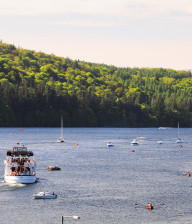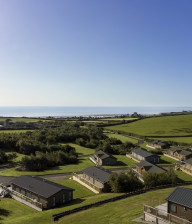

Cumbria - Lake District National Park
Go on a wild adventure in the Lake District
Discover stunning landscapes, charming villages, a warm welcome, and a diverse cultural heritage at this National Park and UNESCO World Heritage Site. Take a wild adventure, wander the fells, or just relax and enjoy the peace. Inhale and feel inspired.


The Lake District has scenery unlike any other in England thanks to its diverse scenery and important freshwater waterways such as pools, clear lakes, tarns, and rivers and provides a variety of habitats for many native animal and plant species. Mires, limestone pavement, upland heath, screes, lakeshore wetlands, estuaries, coastal heath, and dunes all contribute to the impressive landscape and every valley has its own distinct visual and cultural identity because of its unique combination of lakes, farmland, fells and woodland.
The woodlands give the scenery texture and colour and are abundant in Atlantic mosses, liverworts, ferns, and lichens thanks to the high rainfall in the National Park's core.



The Lake District has a huge number of outdoor activity centres so it's an excellent place to visit if you like getting active in the great outdoors. It's also the home of British mountaineering, and has a long history of unrestricted access to the fells and a vast network of public rights of way.
The relatively open nature of the uplands and the lack of modern development are particularly important, as are the tranquillity of the valleys, lakes and the fells. It's a liberating place to be and gives you a sense of wildness as you walk or climb the crags of the fells.
There's no better place to take to the mountains, paths or lakeshores than in the heart of the Lake District. From gentle ambles at Sizergh and Allan Bank, to more challenging fell hikes in Langdale, you’re guaranteed beautiful views and a walk to remember.
Road cyclists and mountain bikers of all levels and levels of experience can choose from quiet country lanes, challenging off-road mountain trails where you can test and improve your riding skills, and official cycleways and bridleways in Cumbria and the Lake District. These include designated off-road trails in the Grizedale and Whinlatter Forests, a number of cycle paths at Lowther Castle in the Eden Valley, and the Eskdale Trail in the Western Lake District, where you can ride a bike and ride a steam train!
A lot of of Britain's most beautiful long distance cycling courses go through the park, offering the opportunity to explore off the beaten track. You can explore the Lakes and Dales Loop or cycle the entire length of Hadrian's Wall; tackle part of the Coast-to-Coast or Pennine Cycleway; or the "Bay Cycle Way," which goes through the Arnside & Silverdale Area of Outstanding Natural Beauty and is 81 miles long.
The rocks in the Lake District provide a dramatic record of nearly 500 million years, including evidence of continents colliding, deep oceans, tropical seas, and ice sheets a kilometre thick. The highest peaks in England and the largest and deepest lakes are found in this region.
The Lake District has rich archaeology because people have lived there since the end of the last Ice Age. With numerous traces of prehistoric and medieval field systems, the landscape reveals a long history of human settlement. Stone circles, Roman roads and forts, and charcoal blast furnaces are examples of archaeological landmarks that have international significance. Waterpower is now the primary source of energy for the mining, gunpowder, and wood-processing industries thanks to the area's high rainfall.
Local materials, such as slate, are a common link between contrasting architectural styles and the distinct character of the settlement. Adding variety are finishes like lime wash and the use of sandstone, granite, and limestone. Hedgerows and dry-stone walls create a visual and historical link between the city and the countryside. Local building practices are reflected in structures like hogg houses, peat houses, packhorse bridges, and bank barns as well as chimneys, windows, and walling.
The Lake District has the largest concentration of common land in Britain, and possibly Western Europe, and its inhabitants have worked the land and contributed to the formation of the landscape, which is reflected in its celebrated cultural traditions. Environmentalists and writers have advocated for the preservation of landscapes. The region has inspired Turner, Heaton Cooper, Kurt Schwitters, Wordsworth, Coleridge, and De Quincey, as well as children's authors Beatrix Potter and Arthur Ransome. The region even has its own dialect and unique sports like fell running, hound trailing, and Cumberland and Westmorland wrestling.


